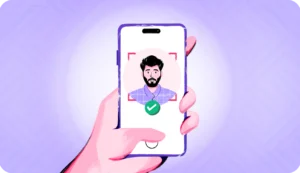The digital lending process in place today is very different from what it was in antiquity, and ‘digital’ has changed the game for lenders. Digital lenders disburse loans and collect repayments through bank accounts or digital wallets with third party integration. Instant disbursement is why many customers opt for a digital lender over a bank or some other service. What this means is that the turnaround time must be very less and the collections must hopefully be automated.
Where do digital lenders and digital lending stand today? Thankfully, today’s digital lenders have a much more accurate underwriting process as they have access to large data banks. These data banks also reduce the turnaround time significantly for the end customer. But data isn’t the only thing that helps digital lending. AI and machine learning also play a big role in the process, AI that helps establish the identity of the customer.
Seems like all is sorted then right? Not quite. The second component that we spoke of, that of intelligence is still quite scarce in customer onboarding for digital lending. In fact, intelligence that can accurately distinguish faces based on their unique traits is not so easily accessible for everyone. And free solutions, such as those from Google and Microsoft, are not very reliable out of the box and cannot be used for real-world face recognition and OCR unless modified.
With digital lending, the onboarding process is the most crucial of them all. This is because if the customer does not find it seamless and frictionless, then they may opt for a competitor. Did you know that over 90% of customers feel that the company they eventually buy from could still do a better job of onboarding customers? And when it comes to digital lenders every applicant profile has to be carefully screened.
To screen applicants effectively, it is necessary that there be some form of KYC (Know your customer) solution integrated into the app.
According to a study, 1 out of 3 FinTech companies have lost customers due to a lengthened or slow onboarding process. Without a proper KYC solution, you would have to rely on just agent assisted onboarding and this can immensely increase turnaround times. The customer would have to wait longer as the agent painstakingly pulls each detail from the company database. But the customer wants the money soon, which is why he opts for a digital service, else he could just go to a bank, couldn’t he?
Not having a KYC with proper face recognition and optical character recognition can also affect collections. If there was an image injection hack that was able to dupe the face recognition software, and there was no 1:N matching detection, then the document information and the facial information will not match. This would make collections very difficult.
Not just that, the person in question can also just say that the collection of information happened without his consent if the image was not captured live by camera. In such a case, the digital lender cannot pursue him/her for collecting money.
There are other reasons why the whole collections part of the digital lending process can suffer. And this is because of agent assisted onboarding. In agent assisted onboarding that is not properly supervised, it is possible that an agent can input the details of a prospect after noticing that he/she qualifies for the loan and gain access to the loan. By providing a bank account that belongs to the agent, the money will be transferred to his/her account. But collections will continue to pursue the person whose documentation and other evidence was provided.
Without proper customer onboarding, the customer satisfaction scores a digital lender receives will also take a hit as the customer experience deteriorates. Word of mouth reviews will affect the digital lender just as bad as online expressions of mistrust or hatred on social media. With so many hundreds of digital lenders in the market, customers will just opt for another competitor.
The last but often unmentioned problem with traditional money lending and even older digital lending processes is that they are not compliant with Anti-money laundering (AML) regulations. To remediate this, firms must have strict AML compliance measures in place. How can customer due diligence be implemented to establish the identity of the person who applies for the loan?
What’s the solution to these problems? Instead of focusing on piecemeal optimization, why not focus on a more holistic one, a single solution that encompasses and rids the digital lender of all four issues? An eKYC coupled with a face liveness match will reduce turnaround times for the customers while also ensuring that the customer satisfaction goes up as he/she now gets the loan much faster.
Let us now look at how to solve the problem of money laundering, ensuring that the money that is used by the person for repayments of the loans is clean money. To ensure this two checks can be performed. The first is customer due diligence which is part of the KYC process in most digital lending platforms. The second and more difficult process is extended due diligence (EDD) that determines the first and original source of the funding.
The problems that affect collection almost seem to be without a solution. But there is one. Video KYC is today replacing regular KYC, and that can help with collections too. Video KYC helps to better establish the identity of the customer and is not susceptible to 2D/3D static or dynamic attacks.
Did you know that with HyperVerge you get an added layer of security that can thwart 2D/3D static and dynamic attacks as well, even with the regular KYC? It even works well to detect any form of image injection. Talk to HyperVerge today!
There’s another advantage to video KYC in digital lending. With video KYC, the transaction between the digital lender and the customer also becomes legal in any court of law. The person who took the loan cannot deny their presence in the video. Most importantly, in cases where an agent assisted onboarding happens, a video KYC is the most apt solution as in the video the person taking the loan clearly states his identity and his intent to take the loan. The agent has little role to play here, that of guiding the customer through the video KYC process and ensuring that it is complete without any errors.
Solutions like eKYC with passive liveness face match and OCR and face recognition built into it can help achieve the business outcomes. It helps achieve lower TAT(turnaround time), the cost savings really help the margins that digital lenders live by, and the manual labor is greatly reduced. All these three things contribute greatly to increase the overall operational efficiency of the digital lending process, also reducing its complexity. And of course the other benefits to adopting an eKYC or Video KYC backed by accurate OCR and face recognition is the AML compliance it provides, and the higher customer satisfaction as a result of all of these.
How HyperVerge can help digital lenders
Using both high accuracy OCR (optical character recognition) and face recognition, and with sufficient training on samples of government documents for a given geography, HyperVerge can help digital lenders meet their operational and compliance requirements in their specific geographies.
- HyperVerge offers a highly accurate face recognition system with passive liveness matching and an end-to-end identity verification platform. This is also supported by a Video KYC system offering an end-to-end onboarding solution for digital lenders.
- The Hyper Turing engine, a proprietary in-house AI engine, helps sharpen the accuracy of the OCR. It also has 99.97% uptime and guarantees a speedy transaction every time.
- The face recognition system also runs parallel 1:N checks to determine identity. HyperVerge recently topped the NIST rankings for the capabilities of its face recognition offerings and various benchmarks.
- The face recognition system is iBeta certified for passive liveness detection. It is accurate and extremely user friendly, and it allows a large number of users to onboard in a given period.
- In addition to the above benefits, HyperVerge surpasses its competitors. To do this, the code for face recognition and OCR are also benchmarked against those of competitors to yield better accuracy over time.
With an end-to-end solution that is able to identify diverse people in different geographies, HyperVerge can revolutionize the digital lending process. Our studies show that the drop off rates fall by 50% on digital lending platforms and turnaround times reduce by around 10 seconds, thanks to HyperVerge. 95% of the processing also happens straight through and does not require a second iteration with HyperVerge.over $30M is saved in fraud losses by FinTechs using HyperVerge worldwide, particularly in Indonesia, Vietnam and the Philippines. Lastly, but also equally important, our face recognition AI works for all races, ages and genders. This is because the AI models have been trained extensively on faces from different regions, age groups and both genders, ensuring that accuracy is maintained. If you are a digital lender looking to enter a new market or even starting out, look to us to get the support that you need. Talk to us today!
FAQs
Can AI reduce customer onboarding time in digital lending?
A well-trained AI can reduce the customer onboarding time to a matter of a few minutes from the hours it would take with manual verification.
What is the typical churn rate on a FinTech platform?
73% of all users on a FinTech platform churn in a matter of 7 days. This is disappointing, and can be solved with better customer onboarding.
How do lending companies make money?
Lending companies make money through a combination of loan origination and loan repayment (interest) fees.
What is the money saved by using the fraud detection services from HyperVerge?
About USD30M in total are saved annually by companies who use the fraud detection services from HyperVerge.





















